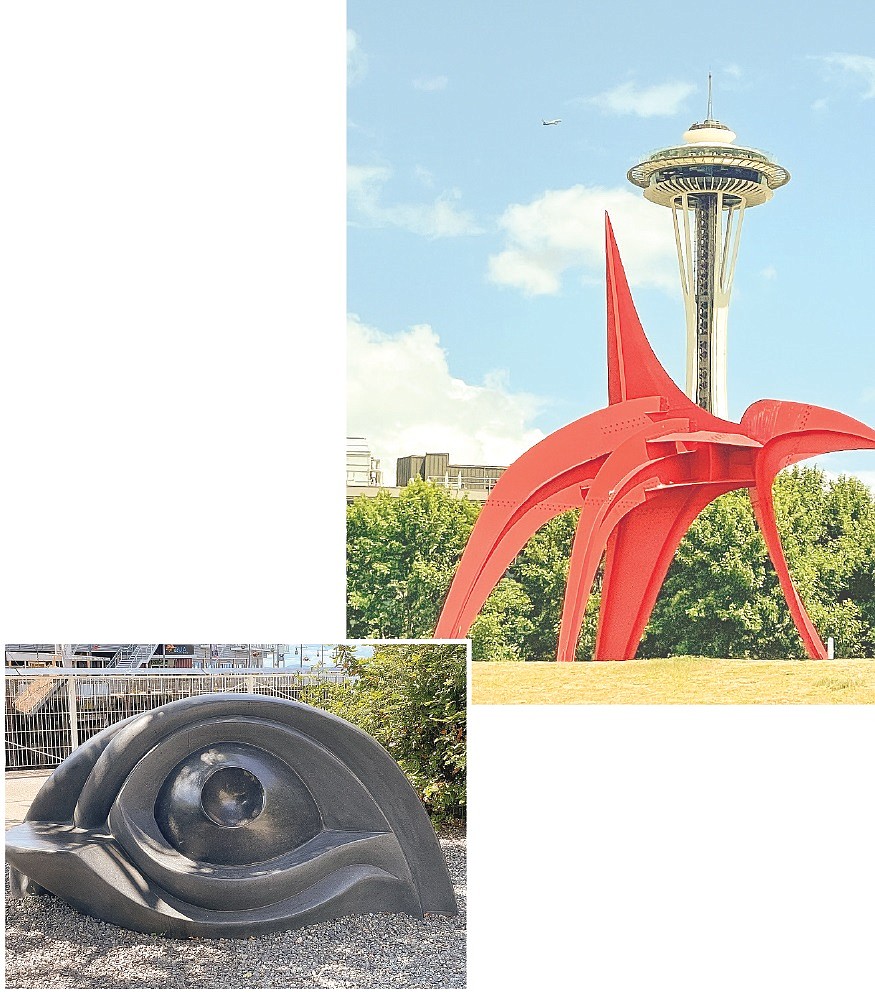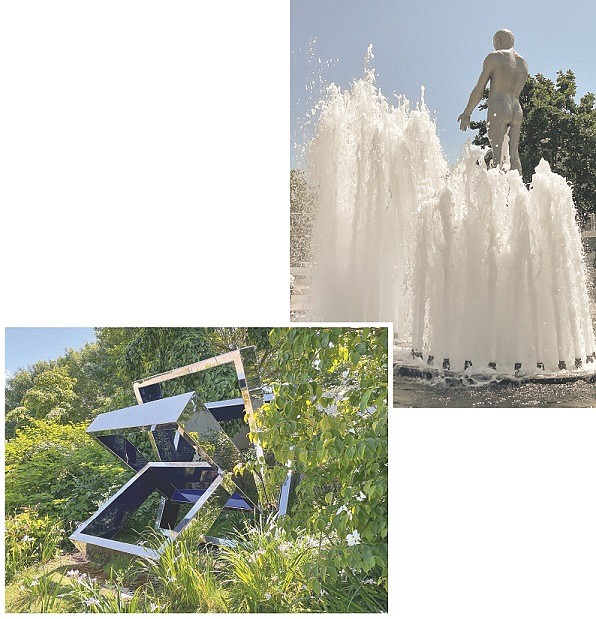Olympic Sculpture Park
Splendid art, splendid views
February 25, 2022 at 12:00 a.m. | Updated March 7, 2022 at 12:00 a.m.
(top photo) Alexander Calder’s “Eagle”
(bottom photo) Louise Bourgeois’ “Eye Benches” double as outdoor seating.
Photos by Debbie Stone
...by ...by Debbie Stone
Outdoor art is a boon for urban areas. It enhances the city, adds color and vibrancy to its cultural fabric and provides unique spaces for artists to showcase their work. Bringing art from behind the walls also offers an opportunity for people to be exposed to different forms of creativity without having to set foot in a museum. And it’s a great way to engage the senses and possibly spur interest in self-expression.
The Olympic Sculpture Park has been a Seattle icon since 2007. The park, which is operated by the Seattle Art Museum, was formerly an industrial site before the museum proposed to transform it into an elegant green space.
This noted outdoor museum is situated on nine picturesque acres. Its zig-zag-shaped design descends forty feet from the city to the sound and boasts views of the skyline and Elliot Bay. The park melds with the landscape, while connecting Seattle’s dynamic urban core to its waterfront.
Largescale modern and contemporary sculptures are positioned throughout the area. Some are visible from everywhere in the park due to their monumental size; others are semi-hidden alongside trails, waiting to be discovered.
Alexander Calder’s “Eagle,” for example, is hard to miss. This massive 39-foot-tall, bright red steel piece resembles an origami figure on steroids. Although it’s an abstract work, the bird references are obvious. There’s a grace to the sculpture as it soars upwards into the sky in majestic fashion.
Richard Serra’s “Wake” is another towering behemoth. Featuring five undulating, acid-washed steel slabs stretching 125 feet, the piece offers a multitude of perspectives depending on your vantage point.
“Seattle Cloud Cover” by Teresita Fernandez is an Impressionist-like stunner. It’s a glass canopy bridge, which displays the changing images of the sky as you walk under it. Nature and art come together with the play of light.
Industrial materials and geometric forms come together in Beverly Pepper’s “Perre’s Ventaglio III.” All hard edges and sleek in design, it appears frozen in a semi-collapsed state.
At the shoreline is “ECHO,” a 46-foot-tall, marble dust-coated sculpture by Jaume Plensa. The piece was named for the mountain nymph of Greek mythology, who offended the goddess Hera... As punishment, Hera took away Echo’s free speech. Plensa’s notable creation depicts the face of a girl with her eyes closed as if in meditation. It is a luminous beacon that rises above the park.
Nearby is another Bourgeois installation titled, “Eye Benches I, II and III.” These black granite pieces resemble giant, disembodied eyeballs that seem to be all-observant. I initially found them disturbing because they seemed to be watching my every move, but then I saw that they doubled as outdoor seating. Once I sat in them, they ceased to be creepy.
Additional benches dot the park, giving viewers places to rest and absorb the art while contemplating its effects on the environs. For some visitors to the park, the sculptures take centerstage; each appreciated for its distinct qualities and impressions. For others, the works are integrated within the landscape, and seen as a complete canvas.
As a greenspace, the park offers respite from the hubbub, a place to picnic, room for kids to run around and even a pocket beach to dip your toes in – all within the heart of Seattle.
Seattle’s waterfront Olympic Sculpture Park is located at 2901 Western Avenue. For information, visit www.seattleartmuseum.org/ visit/olympic-sculpture-park
The Olympic Sculpture Park has been a Seattle icon since 2007. The park, which is operated by the Seattle Art Museum, was formerly an industrial site before the museum proposed to transform it into an elegant green space.
This noted outdoor museum is situated on nine picturesque acres. Its zig-zag-shaped design descends forty feet from the city to the sound and boasts views of the skyline and Elliot Bay. The park melds with the landscape, while connecting Seattle’s dynamic urban core to its waterfront.
Largescale modern and contemporary sculptures are positioned throughout the area. Some are visible from everywhere in the park due to their monumental size; others are semi-hidden alongside trails, waiting to be discovered.
Alexander Calder’s “Eagle,” for example, is hard to miss. This massive 39-foot-tall, bright red steel piece resembles an origami figure on steroids. Although it’s an abstract work, the bird references are obvious. There’s a grace to the sculpture as it soars upwards into the sky in majestic fashion.
Richard Serra’s “Wake” is another towering behemoth. Featuring five undulating, acid-washed steel slabs stretching 125 feet, the piece offers a multitude of perspectives depending on your vantage point.
“Seattle Cloud Cover” by Teresita Fernandez is an Impressionist-like stunner. It’s a glass canopy bridge, which displays the changing images of the sky as you walk under it. Nature and art come together with the play of light.
Industrial materials and geometric forms come together in Beverly Pepper’s “Perre’s Ventaglio III.” All hard edges and sleek in design, it appears frozen in a semi-collapsed state.
At the shoreline is “ECHO,” a 46-foot-tall, marble dust-coated sculpture by Jaume Plensa. The piece was named for the mountain nymph of Greek mythology, who offended the goddess Hera... As punishment, Hera took away Echo’s free speech. Plensa’s notable creation depicts the face of a girl with her eyes closed as if in meditation. It is a luminous beacon that rises above the park.
Nearby is another Bourgeois installation titled, “Eye Benches I, II and III.” These black granite pieces resemble giant, disembodied eyeballs that seem to be all-observant. I initially found them disturbing because they seemed to be watching my every move, but then I saw that they doubled as outdoor seating. Once I sat in them, they ceased to be creepy.
Additional benches dot the park, giving viewers places to rest and absorb the art while contemplating its effects on the environs. For some visitors to the park, the sculptures take centerstage; each appreciated for its distinct qualities and impressions. For others, the works are integrated within the landscape, and seen as a complete canvas.
As a greenspace, the park offers respite from the hubbub, a place to picnic, room for kids to run around and even a pocket beach to dip your toes in – all within the heart of Seattle.
Seattle’s waterfront Olympic Sculpture Park is located at 2901 Western Avenue. For information, visit www.seattleartmuseum.org/ visit/olympic-sculpture-park






